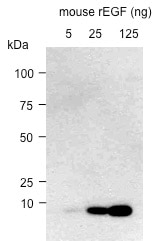Mouse EGF Antibody Summary
Applications
Please Note: Optimal dilutions should be determined by each laboratory for each application. General Protocols are available in the Technical Information section on our website.
Scientific Data
 View Larger
View Larger
Cell Proliferation Induced by EGF and Neutralization by Mouse EGF Antibody. Recombinant Mouse EGF (Catalog # 2028-EG) stimulates proliferation in the Balb/3T3 mouse embryonic fibroblast cell line in a dose-dependent manner (orange line). Proliferation elicited by Recombinant Mouse EGF (0.3 ng/mL) is neutralized (green line) by increasing concentrations of Goat Anti-Mouse EGF Antigen Affinity-purified Polyclonal Antibody (Catalog # AF2028). The ND50 is typically 0.02-0.06 µg/mL.
 View Larger
View Larger
EGF in Mouse Kidney. EGF was detected in perfusion fixed frozen sections of mouse kidney using Goat Anti-Mouse EGF Antigen Affinity-purified Polyclonal Antibody (Catalog # AF2028) at 5 µg/mL overnight at 4 °C. Tissue was stained using the Anti-Goat HRP-DAB Cell & Tissue Staining Kit (brown; Catalog # CTS008) and counterstained with hematoxylin (blue). Specific staining was localized to cytoplasm in convoluted tubules. View our protocol for Chromogenic IHC Staining of Frozen Tissue Sections.
Reconstitution Calculator
Preparation and Storage
- 12 months from date of receipt, -20 to -70 °C as supplied.
- 1 month, 2 to 8 °C under sterile conditions after reconstitution.
- 6 months, -20 to -70 °C under sterile conditions after reconstitution.
Background: EGF
Epidermal growth factor (EGF) is the founding member of the EGF family that also includes TGF-alpha, amphiregulin (AR), betacellulin (BTC), epiregulin (EPR), heparin‑binding EGF‑like growth factor (HB-EGF), epigen, and the neuregulins (NRG)-1 through -6 (1). Members of the EGF family share a structural motif, the EGF‑like domain, which is characterized by three intramolecular disulfide bonds that are formed by six similarly spaced conserved cysteine residues (2). All EGF family members are synthesized as type I transmembrane precursor proteins that may contain several EGF domains in the extracellular region. The mature proteins are released from the cell surface by regulated proteolysis (1). The 1217 amino acid (aa) mouse EGF precursor contains nine EGF domains and nine LDLR class B repeats. The mature protein consists of 53 aa and is generated by proteolytic excision of the EGF domain proximal to the transmembrane region (3). Mature mouse EGF shares 70% and 77% aa sequence identity with mature human and rat EGF. EGF is present in various body fluids, including blood, milk, urine, saliva, seminal fluid, pancreatic juice, cerebrospinal fluid, and amniotic fluid (4). Four ErbB (HER) family receptor tyrosine kinases including EGFR/ErbB1, ErbB2, ErbB3 and ErbB4, mediate responses to EGF family members (5). These receptors undergo a complex pattern of ligand induced homo- or hetero-dimerization to transduce EGF family signals (6, 7). EGF binds ErbB1 and depending on the context, induces the formation of homodimers or heterodimers containing ErbB2. Dimerization results in autophosphorylation of the receptor at specific tyrosine residues to create docking sites for a variety of signaling molecules (5, 8). Biological activities ascribed to EGF include epithelial development, angiogenesis, inhibition of gastric acid secretion, fibroblast proliferation, and colony formation of epidermal cells in culture.
- Harris, R.C. et al. (2003) Exp. Cell Res. 284:2.
- Carpenter, G. and Cohen, S. (1990) J. Biol. Chem. 265:7709.
- Gray, A. et al. (1983) Nature 303:722.
- Carpenter, G. and Zendegui, J.G. (1986) Exp. Cell Res. 164:1.
- Jorissen, R.N. et al. (2003) Exp. Cell Res. 284:31.
- Gamett, D.C. et al. (1997) J. Biol. Chem. 272:12052.
- Qian, X. et al. (1994) Proc. Natl. Acad. Sci. 91:1500.
- Qian, X. et al. (1999) J. Biol. Chem. 274:574.
Product Datasheets
Citations for Mouse EGF Antibody
R&D Systems personnel manually curate a database that contains references using R&D Systems products. The data collected includes not only links to publications in PubMed, but also provides information about sample types, species, and experimental conditions.
6
Citations: Showing 1 - 6
Filter your results:
Filter by:
-
Transcription factors AP-2alpha and AP-2beta regulate distinct segments of the distal nephron in the mammalian kidney
Authors: JO Lamontagne, H Zhang, AM Zeid, K Strittmatt, AD Rocha, T Williams, S Zhang, AG Marneros
Nature Communications, 2022-04-25;13(1):2226.
Species: Mouse
Sample Types: Whole Tissue
Applications: IHC -
Magnesium and Calcium Homeostasis Depend on KCTD1 Function in the Distal Nephron
Authors: AG Marneros
Cell Reports, 2021-01-12;34(2):108616.
Species: Mouse, Transgenic Mouse
Sample Types: Whole Tissue
Applications: IHC -
A critical role for NF2 and the Hippo pathway in branching morphogenesis
Nat Commun, 2016-08-02;7(0):12309.
Species: Mouse
Sample Types: Whole Tissue
Applications: Neutralization -
VEGFR1-positive macrophages facilitate liver repair and sinusoidal reconstruction after hepatic ischemia/reperfusion injury.
Authors: Ohkubo, Hirotoki, Ito, Yoshiya, Minamino, Tsutomu, Eshima, Koji, Kojo, Ken, Okizaki, Shin-ich, Hirata, Mitsuhir, Shibuya, Masabumi, Watanabe, Masahiko, Majima, Masataka
PLoS ONE, 2014-08-27;9(8):e105533.
Species: Mouse
Sample Types: Whole Tissue
Applications: IHC -
Leukotriene B4 type-1 receptor signaling promotes liver repair after hepatic ischemia/reperfusion injury through the enhancement of macrophage recruitment.
Authors: Ohkubo, Hirotoki, Ito, Yoshiya, Minamino, Tsutomu, Mishima, Toshiaki, Hirata, Mitsuhir, Hosono, Kanako, Shibuya, Masabumi, Yokomizo, Takehiko, Shimizu, Takao, Watanabe, Masahiko, Majima, Masataka
FASEB J, 2013-04-29;27(8):3132-43.
Species: Mouse
Sample Types: In Vivo, Whole Tissue
Applications: IHC-Fr, Neutralization -
Tumor development in murine ulcerative colitis depends on MyD88 signaling of colonic F4/80+CD11b(high)Gr1(low) macrophages.
Authors: Schiechl G, Bauer B, Fuss I, Lang SA, Moser C, Ruemmele P, Rose-John S, Neurath MF, Geissler EK, Schlitt HJ, Strober W, Fichtner-Feigl S
J. Clin. Invest., 2011-04-25;121(5):1692-708.
Species: Mouse
Sample Types: In Vivo
Applications: Neutralization
FAQs
No product specific FAQs exist for this product, however you may
View all Antibody FAQsReviews for Mouse EGF Antibody
Average Rating: 4 (Based on 1 Review)
Have you used Mouse EGF Antibody?
Submit a review and receive an Amazon gift card.
$25/€18/£15/$25CAN/¥75 Yuan/¥2500 Yen for a review with an image
$10/€7/£6/$10 CAD/¥70 Yuan/¥1110 Yen for a review without an image
Filter by:






